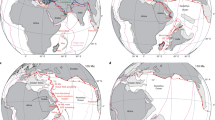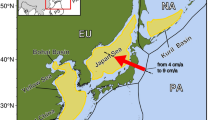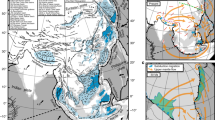Abstract
Cordilleran-type orogens are characterized by the formation of mountain chains and ridges near subduction zones. The growth of orogenic systems is sustained by frictional and viscous stresses, which promote surface uplift. However, horizontal extensional stresses1 also develop, which can contribute to the formation of marginal basins1 and gravitational orogenic collapse2. Here we use a numerical model to assess the effects of the buoyancy of the mantle wedge overlying the subduction zone on the evolution of Cordilleran orogenic systems. Our simulations show that as the subduction velocity decreases, stresses from the buoyancy of the mantle wedge can drive trench retreat and the formation of marginal basins. We find that ultimately, these stresses promote the gravitational collapse of the orogen, detachment of microplates and the break-up of active plate margins. We suggest that the effects of mantle-wedge buoyancy could explain the collapse of the East Gondwana Cordillera3, constructed along the edge of the Australia/East Antarctic craton as the Gondwana and Pacific–Phoenix plates converged4,5,6,7. We propose that 105–90 million years (Myr) ago, a change in the absolute plate motion reduced the subduction velocity, ultimately triggering the gravitational collapse of the orogen and the fragmentation of the active margin.
This is a preview of subscription content, access via your institution
Access options
Subscribe to this journal
Receive 12 print issues and online access
$259.00 per year
only $21.58 per issue
Buy this article
- Purchase on Springer Link
- Instant access to full article PDF
Prices may be subject to local taxes which are calculated during checkout



Similar content being viewed by others
References
Sleep, N. H. Stress and flow beneath island arcs. Geophys. J. R. Astron. Soc. 42, 827–857 (1975).
Rey, P. in Continental Reworking and Reactivation (eds Miller, J. A., Buick, I. S., Hand, M. & Holdsworth, R. E.) J. Geol. Soc. Lond. 184, 372–398 (2001).
Tulloch, A. J. & Kimbrough, D. L. The Paparoa metamorphic core complex, Westland, New Zealand, Cretaceous extension associated with fragmentation of the Pacific margin of Gondwana. Tectonics 8, 1217–1234 (1989).
Weaver, S. D., Bradshaw, J. D. & Adams, C. J. in Geological Evolution of Antarctica (eds Thomson, M. R. A., Crame, J. A. & Thomson, J. W.) 345–351 (Cambridge Univ. Press, 1991).
Mortimer, N. et al. Overview of the Median batholith, New Zealand: A new interpretation of the geology of the Median Tectonic Zone and adjacent rocks. J. Afr. Earth Sci. 29, 257–268 (1999).
Bradshaw, J. D. Cretaceous geotectonic patterns in the New Zealand region. Tectonics 8, 803–820 (1989).
Tulloch, A. J., Beggs, M., Kula, J. L., Spell, T. L. & Mortimer, N. Proc. 2006 New Zealand Petroleum Conf. Ministry of Economic Development, Wellington, New Zealand 11 (Ministry of Economy and Development of New Zealand, 2006).
Barazangi, M. & Isacks, B. Lateral variations of seismic-wave attenuation in the upper mantle above the inclined earthquake zone of the Tonga Island Arc: Deep anomaly in the upper mantle. J. Geophys. Res. 76, 8493–8515 (1971).
Guillot, S., Hattori, K. H., de Sigoyer, J., Nágler, T. & Auzende, A. L. Evidence of hydration of the mantle wedge and its role in the exhumation of eclogites. Earth Planet. Sci. Lett. 193, 115–127 (2001).
Billen, M. & Gurnis, M. A low viscosity wedge in subduction zones. Earth Planet. Sci. Lett. 193, 227–236 (2001).
Hirth, G. & Kohlstedt, D. L. Water in the oceanic upper mantle; implications for rheology, melt extraction, and the evolution of the lithosphere. Earth Planet. Sci. Lett. 144, 93–108 (1996).
Grove, T. L, Chatterjee, N., Parman, S. W. & Médard, E. The influence of H2O on mantle wedge melting. Earth Planet. Sci. Lett. 249, 74–89 (2006).
Ochs, F. A. & Lange, R. A. The density of hydrous magmatic liquids. Science 283, 1314–317 (1999).
Gaetani, G. A. & Grove, T. L. in Inside the Subduction Factory (ed. Eiler, J. M.) 107–134 (Geophysical Monograph 138, American Geophysical Union, 2003).
Rey, P., Vanderheaghe, O. & Teyssier, C. Gravitational collapse of continental crust: Definition, regimes, and modes. Tectonophysics 342, 435–449 (2001).
De Paoli, M. C., Clarke, G. L., Klepeis, K. A., Allibone, A. H. & Turnbull, I. M. The eclogite–granulite transition: Mafic and intermediate assemblages at Breaksea Sound, New Zealand. J. Petrol. (in the press).
Bryan, S. E., Ewart, A., Stephens, C. J., Parianos, J. & Downes, P. J. The Whitsunday Volcanic Province, central Queensland, Australia: Lithological and stratigraphic investigations of a silicic-dominated large igneous province. J. Volcanol. Geotherm. Res. 99, 55–78 (2000).
Spell, T. L., McDougall, I. & Tulloch, A. J. Thermo-chronologic constraints on the breakup of the Pacific Gondwana margin: The Paparoa metamorphic core complex, South Island, New Zealand. Tectonics 19, 433–451 (2000).
Laird, M.G. & Bradshaw, J.D. The break-up of a long-term relationship: The cretaceous separation of New Zealand from Gondwana. Gondwana Res. 7, 273–286 (2004).
Richard, S. M. et al. Cooling history of the northern Ford Ranges, Marie Byrd Land, West Antarctica. Tectonics 13, 837–857 (1994).
Siddoway, C. S., Richard, S., Fanning, C. M. & Luyendyk, B. P. in Gneiss Domes in Orogeny (eds Whitney, D. L., Teyssier, C. T. & Siddoway, C.) Spec. Pap. Geol. Soc. Am. 380, 267–294 (2004).
Siddoway, C. S. in Antarctica: A Keystone in a Changing World: Proc. 10th Int. Symp. Antarctic Earth Sciences (eds Cooper, A. K. et al.) 91–114 (National Academies, 2008).
Waight, T. E. et al. Field characteristics, petrography, and geochronology of the Hohonu Batholith and the adjacent Granite Hill Complex, North Westland, New Zealand. N. Z. J. Geol. Geophys. 40, 1–17 (1997).
Gaina, C., Müller, R. D., Royer, J.-Y. & Symonds, P. A. The tectonic history of the Tasman Sea: A puzzle with 13 pieces. J. Geophys. Res. 103, 12413–12423 (1998).
Lafoy, Y., Brodien, I., Vially, R. & Exon, N. F. Structure of the basin and ridge system west of New Caledonia (Southwest Pacific): A synthesis. Mar. Geophys. Res. 26, 37–50 (2005).
Müller, R. D., Sdrolias, M., Gaina, C., Steinberger, B. & Heine, C. Long-term sea-level fluctuations driven by ocean basin dynamics. Science 319, 1357–1362 (2008).
Lawver, L. A. & Gahagan, L. M. Constraints on timing of extension in the Ross Sea region. Terra Antarctica 1, 545–552 (1994).
Kamp, P. J. J. Tracking crustal processes by FT thermo-chronology in a forearc high (Hikurangi margin, New Zealand) involving Cretaceous subduction termination and mid-Cenozoic subduction initiation. Tectonophysics 307, 313–343 (1999).
Vry, J. K. et al. Zoned (Cretaceous and Cenozoic) garnet and the timing of high-grade metamorphism, Southern Alps, New Zealand. J. Metamorphic Geol. 22, 137–157 (2004).
Kula, J., Tulloch, A., Spell, T. L. & Wells, M. L. Two-stage rifting of Zealandia–Australia–Antarctica: Evidence from 40Ar/39Ar thermochronometry of the Sisters shear zone, Stewart Island, New Zealand. Geology 35, 411–414 (2007).
Acknowledgements
This work was supported by AUSCOPE-NCRIS and Computational Infrastructure for Geodynamics software infrastructure. P.F.R. thanks the Australian Research Council for supporting this research through grant ARC-A00103441 and ARC-DP 0987608.
Author information
Authors and Affiliations
Contributions
P.F.R. proposed the paper’s main concept, designed the numerical experiments and wrote the bulk of the paper. R.D.M. provided the palaeogeographic reconstruction, contributed to the interpretation of the results and the writing of the paper.
Corresponding author
Ethics declarations
Competing interests
The authors declare no competing financial interests.
Supplementary information
Supplementary Information
Supplementary Information (PDF 311 kb)
Rights and permissions
About this article
Cite this article
Rey, P., Müller, R. Fragmentation of active continental plate margins owing to the buoyancy of the mantle wedge. Nature Geosci 3, 257–261 (2010). https://doi.org/10.1038/ngeo825
Received:
Accepted:
Published:
Issue Date:
DOI: https://doi.org/10.1038/ngeo825
This article is cited by
-
The role of gravitational body forces in the development of metamorphic core complexes
Nature Communications (2022)
-
Coupled influence of tectonics, climate, and surface processes on landscape evolution in southwestern North America
Nature Communications (2022)
-
The geological history and evolution of West Antarctica
Nature Reviews Earth & Environment (2020)
-
Cordillera Zealandia: A Mesozoic arc flare-up on the palaeo-Pacific Gondwana Margin
Scientific Reports (2017)
-
Microplate motion
Nature Geoscience (2010)



